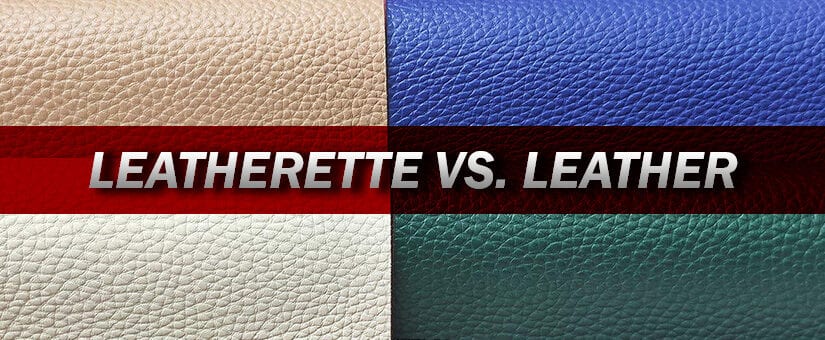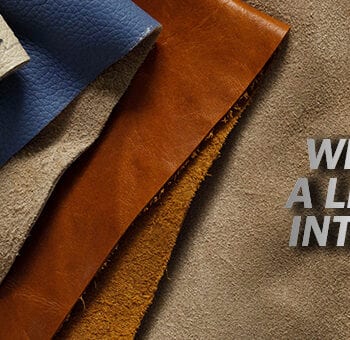
Leatherette vs. Leather
When it comes to car upholstery, new vehicles today offer a variety of choices, including cloth, vinyl, microsuede, leather, and leatherette. Now, don’t let the fact that they both have “leather” in the name fool you — there are some big differences between the fabrics, and each comes with a unique set of pros and cons that might make more sense for different buyers.
Leatherette
Leatherette is a synthetic material made from vinyl or some type of plastic. You may also hear leatherette referred to as faux leather, fake leather, synthetic leather or pleather. While leatherette contains no animal by-products, it’s made specifically to mimic the look and feel of real leather.
Leather
Made from animal hides treated with chemicals, leather is a luxurious fabric. In most cases, leather comes from cows, and the manufacturing process involves multiple steps. The quality of the leather depends on the animal type and breed, the climate in which the animal lived, the layer of the hide that is used, and the skill of the workers who perform the processing and tanning.
The Pros of Leatherette
Some car owners opt for leatherette over leather because the synthetic material carries its share of benefits. In modern cars, leatherette often looks so much like real leather that it’s hard to tell the difference. That it’s considerably cheaper than leather is another draw for consumers.
Because leatherette isn’t a porous material, it is waterproof, making it easy to wipe away spills and dirt with only a damp cloth. This is an advantage for car owners with kids. The low-maintenance fabric doesn’t require any time-consuming maintenance or cleaning agents.
Leatherette doesn’t fade as it ages like leather, and since it’s dyed, it’s available in a wide array of color choices. Leatherette has the added advantage of being animal-friendly, as long as it’s not made from scraps of leather.
The Cons of Leatherette
Despite its attractive price tag, leatherette upholstery does have its share of drawbacks. The material doesn’t breath as well as leather, which means it can stick to your skin during those hot summer months (leatherette also tends to feel hotter when the temperature rises).
It’s also not as durable as leather, often lasting ten years or less. The top layer of leatherette upholstery tends to crack as it wears, resulting in a more worn appearance and revealing the cloth layer underneath.
For those considering the environmental aspects, it’s important to note that leatherette is made using non-renewable materials and is not biodegradable.
The Pros of Leather
There are many benefits that make leather such a sought-after option for car interiors. High-quality leather is soft and pliable, making it a comfortable material for automotive interiors. Real leather also has a fresh aroma that’s often associated with new cars and highly desirable for car buyers.
Since leather is extremely durable, it can maintain its condition for decades, resisting punctures and tears. The material also becomes softer with age. Leather is also porous, allowing it to breathe well, ensuring it’s still comfortable for those who live in hot climates. If allergies are a consideration for you, leather may be a good choice, since allergens don’t become trapped in the material.
While leather does require some care, it will help the resale value of a car if the upholstery is kept in excellent condition.
If you’re looking to clean your car’s leather seats (or have them cleaned), it’s important to follow the manufacturer’s instructions when choosing leather upholstery cleaning agents. The wrong products can strip the natural oils from your leather. As an environmental benefit, leather is biodegradable after 50 years.
The Cons of Leather
Leather, considered a luxury item, typically costs more than leatherette upholstery. Despite its durability, leather can fade as a result of exposure to the sun’s rays. Leather also requires some maintenance to keep the material in its best condition, including treatments to help prevent the degradation that occurs with aging.
Since leather is a natural fabric, you usually have fewer choices when it comes to color. Most leather interiors are black or brown, while some are white. Leather absorbs dirt, spills, and odors easily, which leads to staining and discoloration, so it may not be a good option for car buyers with children.
Further, with perforated leathers, crumbs and dirt can get stuck in the small holes, making cleaning a difficult task. The material also scratches easily, an important consideration for those with pets. For some car owners, leather is out of the question because it’s made from animals and manufactured with chemicals.
What’s the Right Choice?
The choice between leather and leatherette comes down to your own needs and wants. Consider your priorities, the climate in your area and your car-buying budget.
Think about whether you’ll be hauling kids or pets regularly, the amount of time you plan on owning the vehicle, environmental and ethical factors of the two materials and the amount of time you’re willing to put into taking care of your car’s interior.
This article was originally posted here

- Posted by Jason Ellington
- 0 Comment


